Machine Learning-Based Methodology for Fast Assessment of Battery Health Status
Abstract
1. Introduction
2. Experimental Set-Up and Data Acquisition
3. Methodology–Machine Learning
3.1. Feature Extraction for Machine Learning
3.2. Machine Learning
3.3. Evaluation Indicators
4. Results and Discussion
Funding
Data Availability Statement
Conflicts of Interest
References
- Mala, P.; Palanivel, M.; Priyan, S.; Anbazhagan, N.; Acharya, S.; Joshi, G.P.; Ryoo, J. Sustainable decision-making approach for dual-channel manufacturing systems under space constraints. Sustainability 2021, 13, 11456. [Google Scholar] [CrossRef]
- Lee, H.D.; Lim, O.T. Policy suggestion for fostering the industry of using end-of-life EV batteries. Trans. Korean Hydrog. New Energy Soc. 2021, 32, 263–270. [Google Scholar] [CrossRef]
- Harper, G.; Sommerville, R.; Kendrick, E.; Chong, W.; Curran, S.M.D.; Roberts, D.A.; Anderson, P.; Scarr, M.O.; Gaines, P.S.J.; Denton, L.A.J.; et al. Recycling lithium-ion batteries from electric vehicles. Nature 2019, 575, 75–86. [Google Scholar] [CrossRef] [PubMed]
- Wang, Y.; Tian, J.; Sun, Z.; Wang, L.; Xu, R.; Li, M.; Chen, Z. A comprehensive review of battery modeling and state estimation approaches for advanced battery management systems. Renew. Sustain. Energy Rev. 2020, 131, 110015. [Google Scholar] [CrossRef]
- Yao, L.; Xu, S.; Tang, A.; Zhou, F.; Hou, J.; Xiao, Y.; Fu, Z. A review of lithium-ion battery state of health estimation and prediction methods. World Electr. Veh. J. 2021, 12, 113. [Google Scholar] [CrossRef]
- Das, K.; Kumar, R. Electric vehicle battery capacity degradation and health estimation using machine-learning techniques: A review. Clean Energy 2023, 7, 1268. [Google Scholar] [CrossRef]
- Jung, C.; Choi, W. Rapid estimation of battery storage capacity through multiple linear regression. Batteries 2023, 9, 424. [Google Scholar] [CrossRef]
- Ye, Z.; Yu, J.; Mao, L. Multisource domain adaptation for health degradation monitoring of lithium-ion batteries. IEEE Trans. Transp. Electrif. 2021, 7, 2279–2292. [Google Scholar] [CrossRef]
- Liu, X.; Yang, C.; Meng, Y.; Zhu, J.; Duan, Y. Capacity estimation of Li-ion battery based on transformer-adversarial discriminative domain adaptation. AIP Adv. 2023, 13, 075203. [Google Scholar] [CrossRef]
- Li, Y.; Liu, K.; Foley, A.M.; Zülke, A.; Berecibar, M.; Nanini-Maury, E.; Hoster, H.E. Data-driven health estimation and lifetime prediction of lithium-ion batteries: A review. Renew. Sustain. Energy Rev. 2019, 113, 109254. [Google Scholar] [CrossRef]
- Zhang, Z.; Gu, X.; Zhu, Y.; Wang, T.; Gong, Y.; Shang, Y. Data-driven available capacity estimation of lithium-ion batteries using fragmented charge capacity. Nat. Commun. Eng. 2025, 32, 2731–3395. [Google Scholar]
- Yao, J.; Han, T. Data-driven lithium-ion batteries capacity estimation based on deep transfer learning using partial segments of charging/discharging data. Energy 2023, 271, 127033. [Google Scholar] [CrossRef]
- Huang, S.; Wang, X.; Kang, L.; Xie, D.; Zhang, X. State of health estimation for lithium-ion battery using partial incremental capacity curves and transfer learning. Batteries 2024, 10, 324. [Google Scholar] [CrossRef]
- Guo, X.; Xu, B.; Zheng, L.; Xu, J. Robustness enhanced capacity estimation method for lithium-ion batteries based on multi-voltage-interval incremental capacity peaks. Front. Energy Res. 2023, 11, 1207194. [Google Scholar] [CrossRef]
- Chen, Y.; Duan, W.; He, Y.; Wang, S.; Fernandez, C. A hybrid data driven framework considering feature extraction for battery state of health estimation and remaining useful life prediction. Green Energy Intell. Transp. 2024, 3, 100160. [Google Scholar] [CrossRef]
- Beltran, H.; Sansano, E.; Pecht, M. Machine learning techniques suitability to estimate the retained capacity in lithium-ion batteries from partial charge/discharge curves. J. Energy Storage 2023, 59, 106346. [Google Scholar] [CrossRef]
- Bharath, Y.K.; Anandu, V.P.; Vinatha, U.; Sudeep, S. Long-term estimation of SoH using cascaded LSTM-RNN for lithium batteries subjected to aging and accelerated degradation. Energy Storage 2024, 10, 70066. [Google Scholar] [CrossRef]
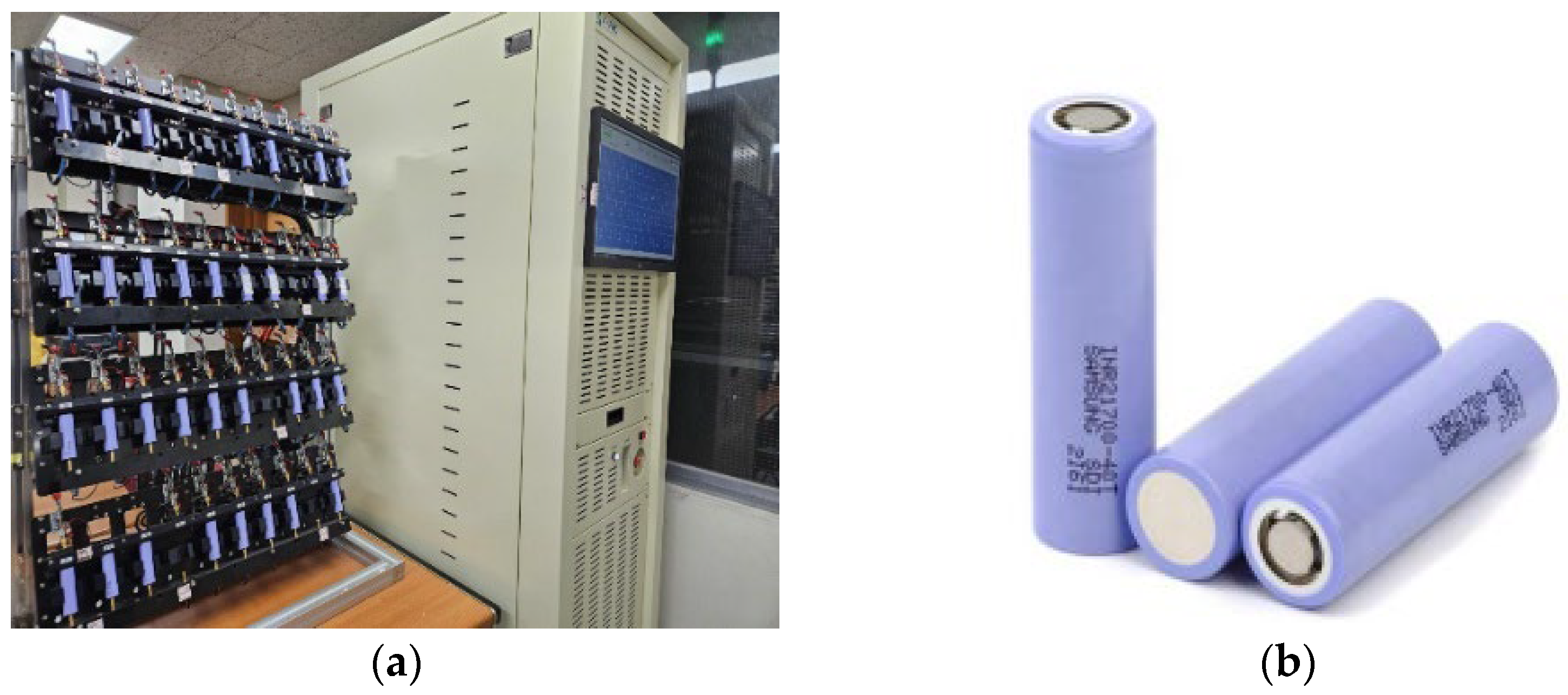
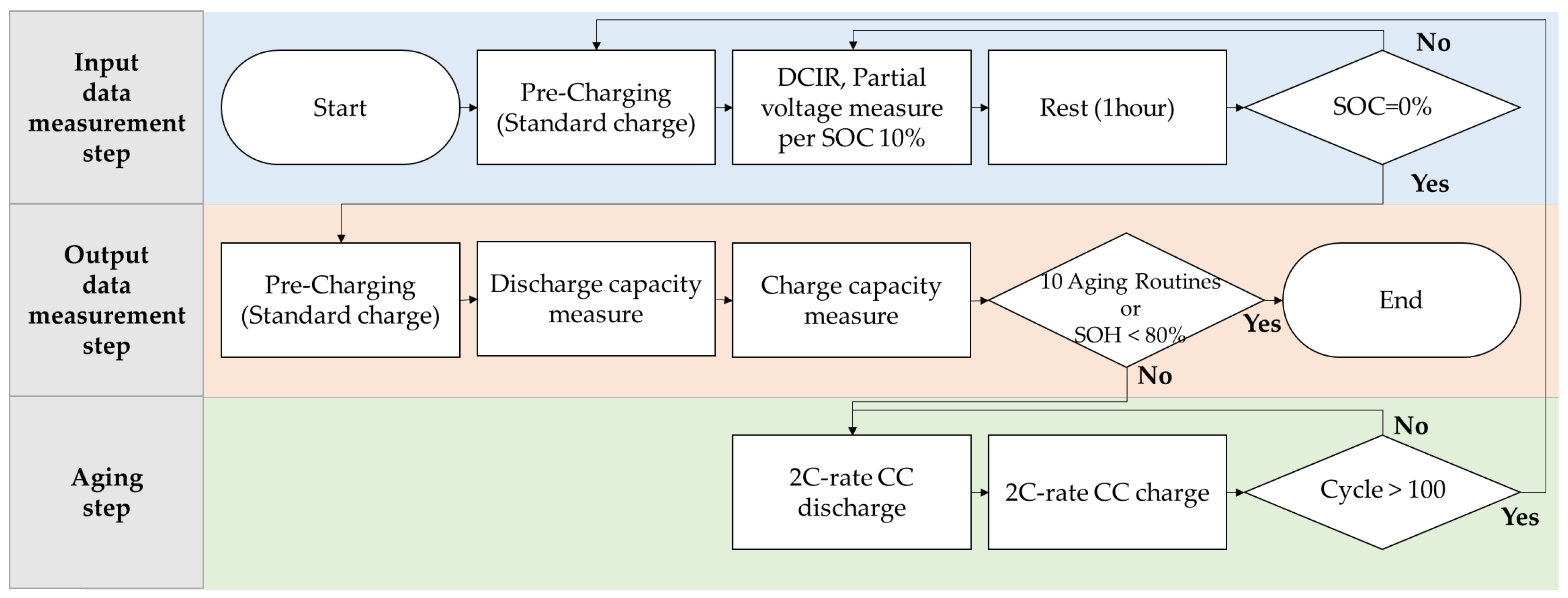
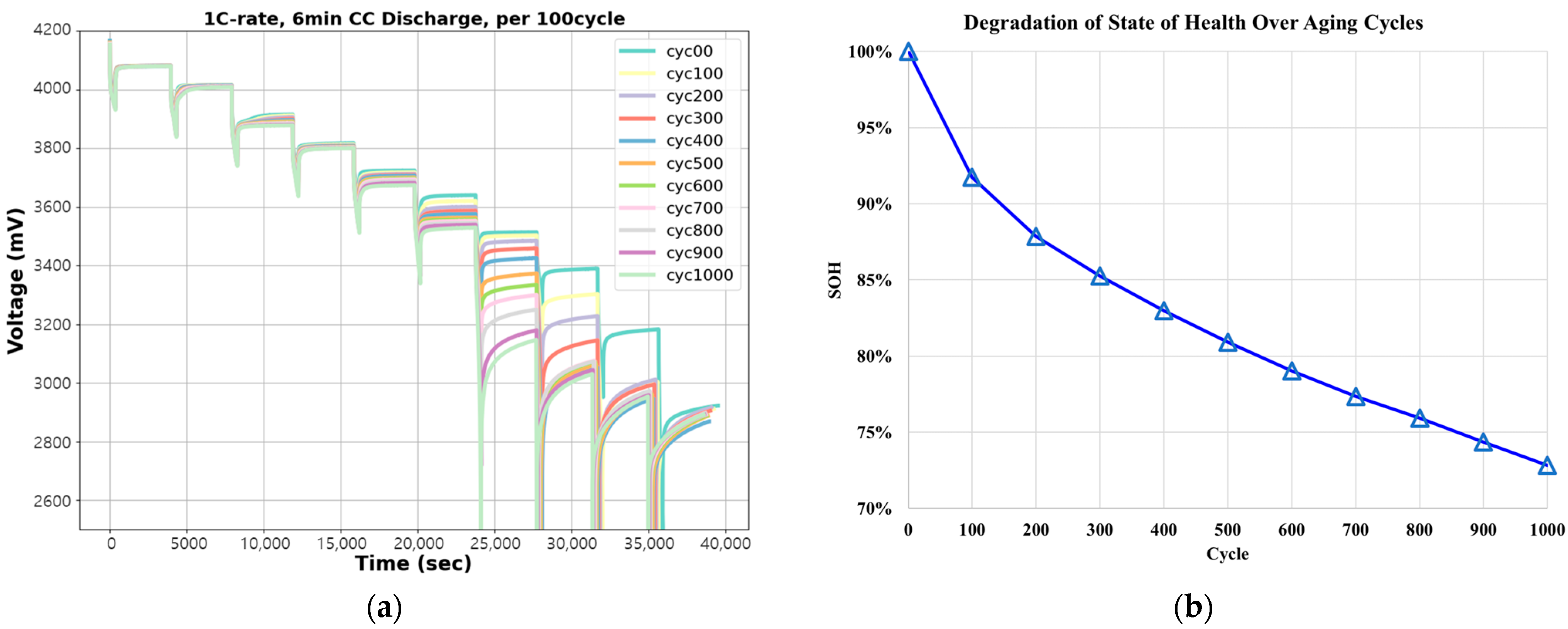

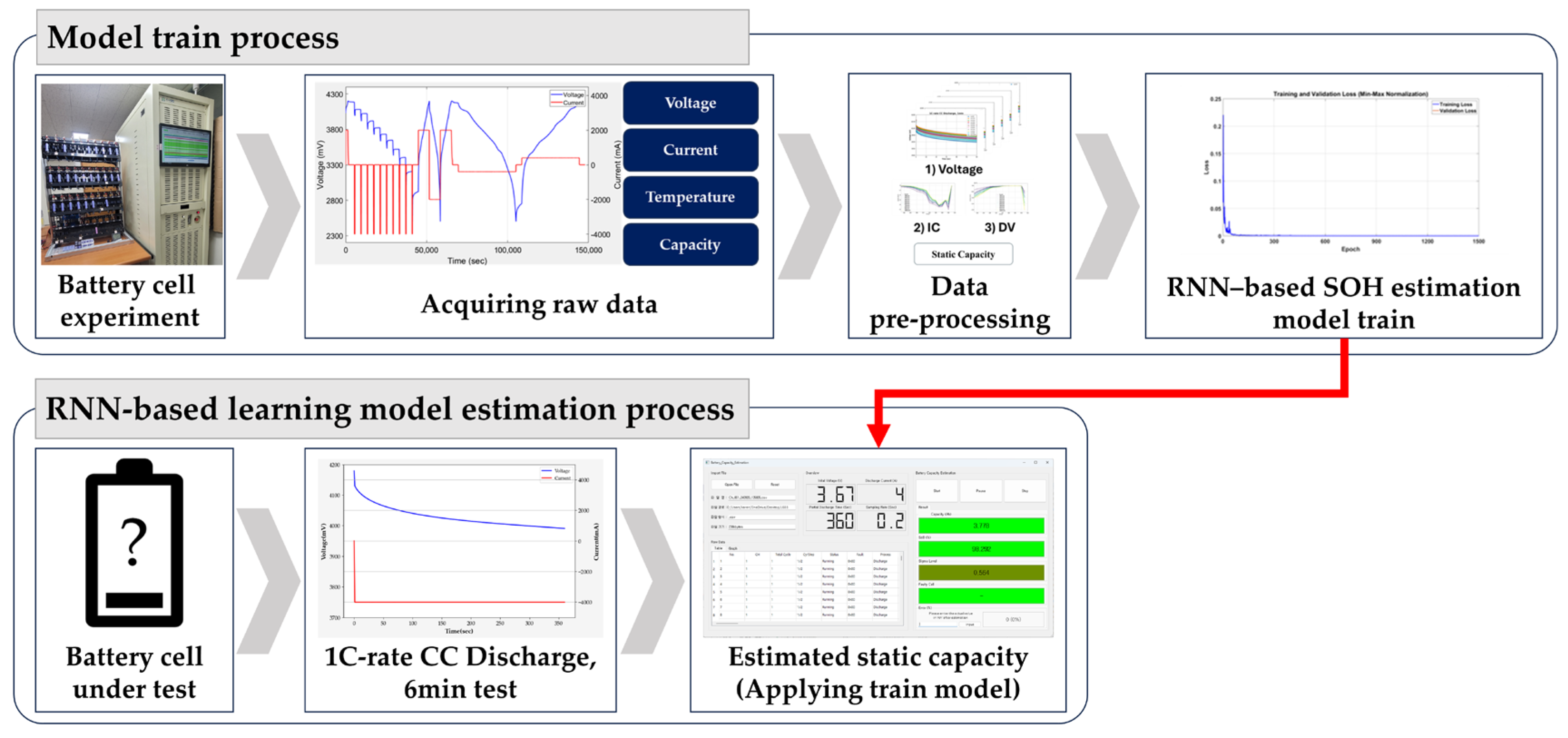
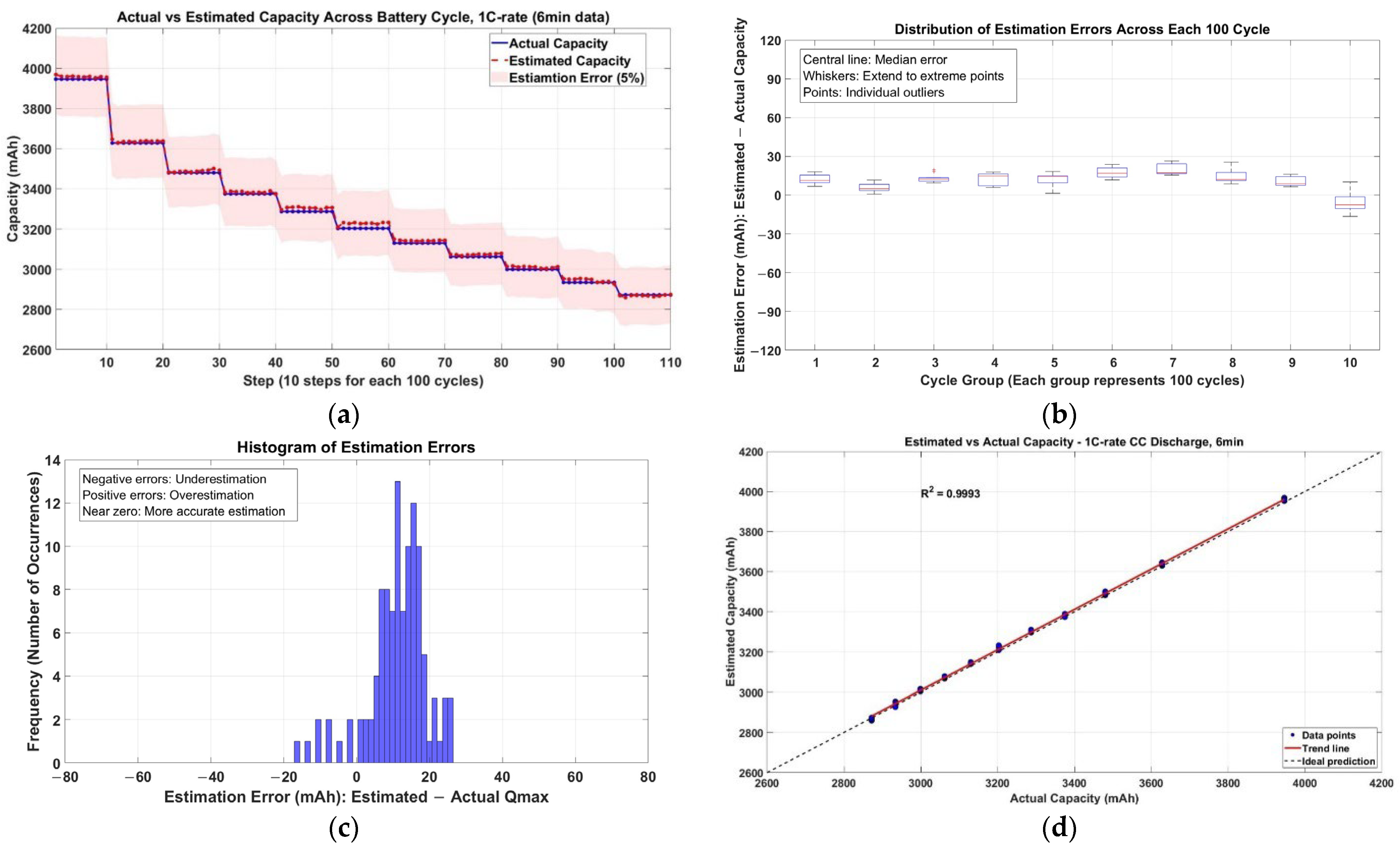
| Parameter | Value | Unit |
|---|---|---|
| Rated voltage | 5 | V |
| Rated current | ±20/each channel | A |
| Data processing rate | Min 100 | ms |
| Accuracy (voltage, current) | Full Scale ± 0.1 | % |
| Accuracy (power) | Full Scale ± 0.2 | % |
| Parameter | Value | Unit |
|---|---|---|
| Nominal capacity | 4000 | mAh |
| Charging cut-off voltage | 4.2 ± 0.05 | V |
| Nominal voltage | 3.6 | V |
| Discharging cut-off voltage | 2.5 | V |
| Parameter | Min. | Max. | Average |
|---|---|---|---|
| RMSE | 15.486 mAh | 44.366 mAh | 28.439 mAh |
| MSE | 239.836 mAh2 | 1968.836 mAh2 | 808.799 mAh2 |
| MAE | 20.734 mAh | 33.795 mAh | 13.049 mAh |
| R2 | - | 0.9993 | |
Disclaimer/Publisher’s Note: The statements, opinions and data contained in all publications are solely those of the individual author(s) and contributor(s) and not of MDPI and/or the editor(s). MDPI and/or the editor(s) disclaim responsibility for any injury to people or property resulting from any ideas, methods, instructions or products referred to in the content. |
© 2025 by the author. Licensee MDPI, Basel, Switzerland. This article is an open access article distributed under the terms and conditions of the Creative Commons Attribution (CC BY) license (https://creativecommons.org/licenses/by/4.0/).
Share and Cite
Choi, W. Machine Learning-Based Methodology for Fast Assessment of Battery Health Status. Batteries 2025, 11, 236. https://doi.org/10.3390/batteries11070236
Choi W. Machine Learning-Based Methodology for Fast Assessment of Battery Health Status. Batteries. 2025; 11(7):236. https://doi.org/10.3390/batteries11070236
Chicago/Turabian StyleChoi, Woongchul. 2025. "Machine Learning-Based Methodology for Fast Assessment of Battery Health Status" Batteries 11, no. 7: 236. https://doi.org/10.3390/batteries11070236
APA StyleChoi, W. (2025). Machine Learning-Based Methodology for Fast Assessment of Battery Health Status. Batteries, 11(7), 236. https://doi.org/10.3390/batteries11070236








